HLTAAP001 Recognise Healthy Body Systems
|
HLTAAP001 Recognise Healthy Body Systems |
ASSESSMENT OVERVIEW
This Student Assessment Booklet-I includes Task 1 and Task 2 for assessment of HLTAAP001 Recognise healthy body systems
ABOUT YOUR ASSESSMENTS
This unit requires that you complete 3 assessment tasks. You are required to complete all tasks to demonstrate competency in this unit.
|
Assessment Task |
About this task |
|
Assessment Task 1: Written questions |
You must correctly answer all questions to show that you understand the knowledge required of this unit. |
|
Assessment Task 2: Project – information brochure |
You are developing an information brochure about maintaining a healthy body. |
|
Assessment Task 3: Workplace project |
You need to complete this task in your workplace. You will need to: § obtain information about the physical health status of a client § participate in a physical health check (or observe one being undertaken) § identify variations from normal health § gather suitable health information to share with others. |
|
PERFORMANCE EVIDENCE |
The candidate must show evidence of the ability to complete tasks outlined in elements and performance criteria of this unit, manage tasks and manage contingencies in the context of the job role. There must be evidence that the candidate has:
- worked effectively with information about the human body and its healthy functioning in at least 3 different situations
|
KNOWLEDGE EVIDENCE |
The candidate must be able to demonstrate essential knowledge required to effectively complete tasks outlined in elements and performance criteria of this unit, manage tasks and manage contingencies in the context of the work role. This includes knowledge of:
- basic structure and functions of the body systems and associated components, including:
- cells, tissues, and organs
- cardiovascular system
- respiratory system
- musculo-skeletal system
- endocrine system
- digestive system
- urinary system
- reproductive system
- integumentary system
- lymphatic system
- the nervous system, including sensory systems – eye and ear
- the special senses – smell, taste, vision, equilibrium, and hearing
- immune system
- processes, conditions, and resources required by the body to support healthy functioning
- body regulation including:
- maintenance of body temperature
- fluid and electrolyte (including PH) balance
- elimination of wastes from the body
- maintenance of blood pressure
- protection from infection
- physical activity – active and passive
|
ASSESSMENT TASK 1: WRITTEN QUESTIONS |
|
Task summary: § This is an open book test – you can use the Internet, textbooks and other documents to help you with your answers if required. § You must answer all questions correctly. § Write your answers in the space provided. § If you need more space, you can use extra paper. All extra pieces of paper must include your name and the question number/s you are answering. § You may like to use a computer to type your answers. Your assessor will tell you if you can email them the file or if you need to print a hard copy and submit it. |
What do I need in order to complete this assessment?
- Access to textbooks or other learning materials.
- Access to a computer and the Internet (if you prefer to type your answers).
When do I do this task?
- You will do this task in the classroom or as homework – your assessor will advise.
what do I need to do if I get something wrong?
If your assessor marks any of your answers as incorrect, they will talk to you about resubmission. You will need to do one of the following:
- Answer the questions that were incorrect in writing.
- Answer the questions that were incorrect verbally.
Instructions to students:
Written answer question guidance
The following written questions use a range of ‘instructional words’, such as ‘identity' or ‘explain’. These words guide students as to how they should answer the question. Use the definitions below to assist you in determining whether the student has provided enough detail (the guidance is the minimum level of response required).
- Analyse – when a question asks students to ‘analyse’, they should do so in detail, identifying important points and key features. Generally, students are expected to write a response of one to two paragraphs in length.
- Compare – when a question asks students to ‘compare’, they will need to show how two or more things are similar, ensuring they also indicate the relevance of the consequences. Generally, students are expected to write a response of one or two paragraphs in length.
- Contrast – when a question asks students to ‘contrast’, they will need to show how two or more things are different, ensuring they indicate the relevance or the consequences. Generally, students are expected to write a response of one or two paragraphs in length.
- Discuss – when a question asks students to ‘discuss’, they are required to point out important issues or features, and express some form of critical judgment. Generally, students are expected to write a response of one or two paragraphs in length.
- Describe – when a question asks students to ‘describe’, they will need to state the most noticeable qualities or features. Generally, they are expected to write a response of two or three sentences in length.
- Evaluate – when a question asks students to ‘evaluate’, they should do so putting forward arguments for and against something. Generally, they are expected to write a response of one or two paragraphs in length.
- Examine – when a question asks students to ‘examine’, this is similar to ‘analyze’. Students will need to provide a detailed response with key points and features and provide critical analysis. Generally, students are expected to write a response of one or two paragraphs in length.
- Explain – when a question asks students to ‘explain’, they will need to make clear how or why something happened or the way it is. Generally, they are expected to write a response of two or three sentences in length.
- Identify – when a question asks students to ‘identify’, they will need to briefly describe the required information. Generally, they are expected to write a response of two or three sentences in length.
- List – when a question asks students to ‘list’, this means they will need to briefly state information in a list format, often with a specific number of items indicated.
- Outline – when a question asks students to ‘outline’, this means giving only the main points. Generally, students are expected to write a response of two or three sentences in length.
- Summarise – when a question asks students to ‘summarise’, this is similar to ‘outline’, only giving the main points. Generally, students are expected to write a response of two or three sentences in length.
Question 1
a. Draw an arrow to identify the parts of the cardiovascular system to their location on the diagram.
Aorta
Left atrium
Left ventricle
Right ventricle
Right atrium
Pulmonary veins
Pulmonary arteries
Inferior vena cava
Superior vena cava
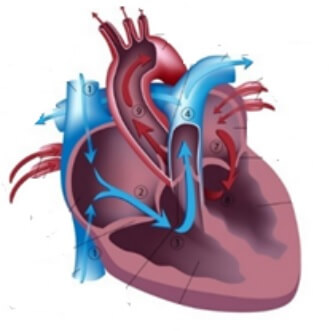
b. Refer to the diagram above of the cardiovascular system and explain how blood flows through the heart.
c. Describe the functions of the cardiovascular system.
Question 2
a. Draw an arrow to identify the parts of the respiratory system to their location on the diagram.
Nasal cavity
Pharynx
Larynx
Trachea
Right lung
Right main bronchus
Bronchiole
Pleura
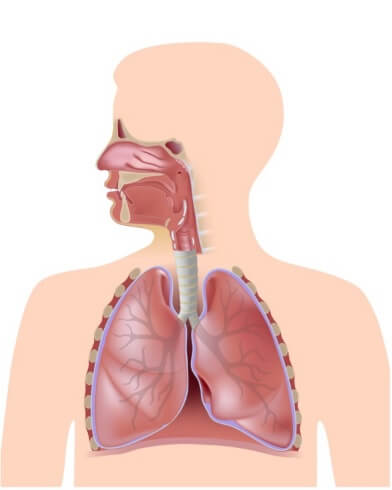
b. Describe the functions of the respiratory system.
Question 3
a. Identify the three main parts of the muscular system and briefly explain the purpose of each.
|
1. |
|
2. |
|
3. |
b. Identify the two main parts of the skeletal system.
|
1. |
|
2. |
c. Describe the functions of the musculoskeletal system.
Question 4
a. Identify where each of the following glands from the endocrine system is located and briefly explain the purpose of each.
- Hypothalamus
- Pituitary gland
- Thyroid gland
- Parathyroid glands
- Adrenal glands
- Pineal gland
- Reproductive glands
- Pancreas
b. Describe the function of the endocrine system.
Question 5
a. Identify the two parts of the nervous system and briefly explain their function.
|
1. |
|
2. |
b. Describe the function of the nervous system.
Question 6
a. Draw an arrow to identify the parts of the digestive system to their location on the diagram.
Esophagus
Liver
Stomach
Gall bladder
Duodenum
Jejunum
Ileum
Colon
Rectum
Anus
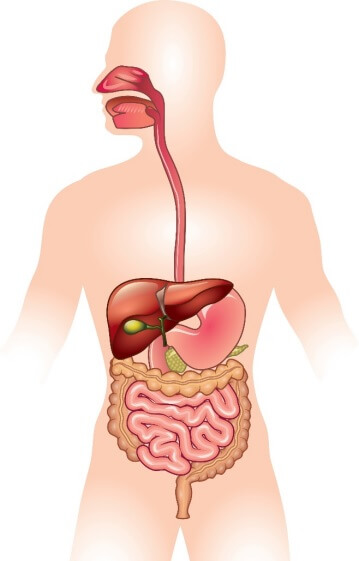
b. Describe the function of the digestive system, including how waste is removed from the body.
Question 7
a. Identify the four main parts of the urinary system and provide a brief explanation of the function of each.
|
1. |
|
2. |
|
3. |
|
4. |
b. Describe the function of the urinary system as a whole, including its role in regulating fluid and electrolyte balance in the body.
Question 8
a. Identify the five main parts of the female reproductive system and provide a brief explanation of their function.
|
1. |
|
2. |
|
3. |
|
4. |
|
5. |
b. Identify the three main parts of the male reproductive system and provide a brief explanation of their function.
|
1. |
|
2. |
|
3. |
c. Describe the function of the human reproductive system.
Question 9
a. Provide a definition of the integumentary system and explain its function.
b. Identify the three layers of tissue of human skin.
|
Top layer | |
|
Middle layer | |
|
Deepest layer |
c. Draw an arrow to identify the parts of the integumentary system to their location on the diagram
Hair
Epidermis
Sebaceous gland
Sweat gland duct
Dermis
Subcutaneous layer
Nerve
Touch receptor
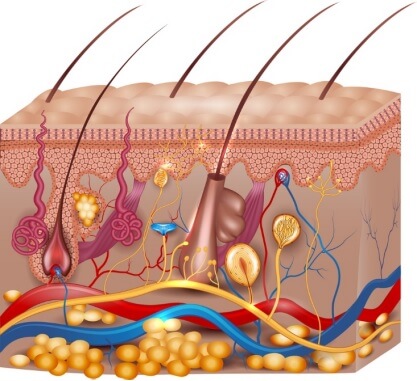
Question 10
Describe the function of the lymphatic system. In your response, identify the six lymphatic organs.
Question 11
Describe in one paragraph each how each of the following functions occurs in the human body.
- Smell
- Taste
- Vision
- Equilibrium
- Hearing
Question 12
a. Provide a definition of ’cells’.
b. Identify the components of a cell as shown in the figure below:
|
A. | |
|
B. | |
|
C. | |
|
D. | |
|
E. | |
|
F. | |
|
G. | |
|
H. | |
|
I. | |
|
J. | |
|
K. | |
|
L. | |
|
M. | |
|
N. | |
|
O. | |
|
P. | |
|
Q. | |
|
R. | |
|
S. |
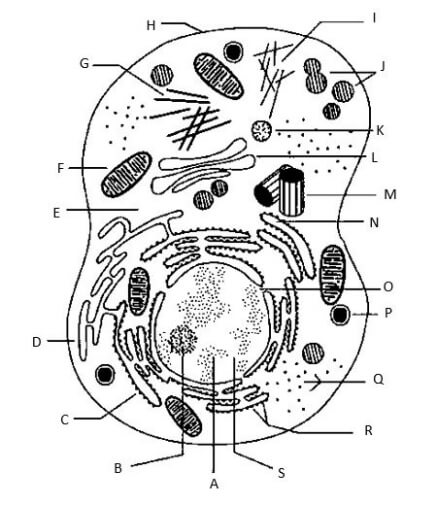
c. Explain the function of the following:
|
Mitochondria | |
|
Ribosomes | |
|
Golgi apparatus | |
|
Nucleus | |
|
Lysosomes | |
|
Endoplasmic reticulum (smooth and rough) |
d. Provide a definition of human body tissue. In your answer, identify the four principal types of tissue and briefly explain their function.
e. Identify the 11 major organ systems of the human body.
|
1. |
|
2. |
|
3. |
|
4. |
|
5. |
|
6. |
|
7. |
|
8. |
|
9. |
|
10. |
|
11. |
Question 13
a. Explain how food and nutrition affect health and contribute to a healthy body.
b. In the following table, explain the purpose of each food type and what foods or other locations it may be obtained from.
|
Food type |
Purpose |
Where it may be obtained |
|
Protein | ||
|
Carbohydrate | ||
|
Fat | ||
|
Vitamin A | ||
|
Vitamin B1 (Thiamine) | ||
|
Vitamin B12 | ||
|
Vitamin C | ||
|
Vitamin D | ||
|
Vitamin K | ||
|
Sodium | ||
|
Potassium | ||
|
Calcium |
Question 14
List 10 recommendations you would make to an older person to maintain their body as healthily as possible (assume they have no medical conditions).
|
1. | |
|
2. | |
|
3. | |
|
4. | |
|
5. | |
|
6. | |
|
7. | |
|
8. | |
|
9. | |
|
10. |
Question 15
a. In the following table, provide a definition for each health terminology term.
|
Terminology |
Definition |
|
Analgesic | |
|
Anorexia | |
|
Arthritis | |
|
Breakthrough pain | |
|
Catheter | |
|
Diuretic | |
|
Dyspraxia | |
|
Hallucination | |
|
Infarction | |
|
Prosthesis | |
|
Scabies | |
|
Thrombosis |
b. Explain the difference between ‘contagious’ and ‘infectious’.
Question 16
a. Explain how the cardiovascular and respiratory systems work together to ensure healthy body function.
b. Explain how the integumentary and nervous systems work together to ensure healthy body function.
Question 17
a. Describe the function of the immune system.
b. The immune system is broken up into two parts – the innate system and the adaptive immune system. In the following table describe each of these systems.
|
Innate system | |
|
Adaptive immune system |
c. Provide a brief definition of immunodeficiency.
d. List four external methods of protecting the body from infection.
|
1. |
|
2. |
|
3. |
|
4. |
e. List four healthy living strategies to help improve the immune system.
|
1. |
|
2. |
|
3. |
|
4. |
Question 18
a. Explain how the body maintains its temperature when the outside atmosphere is hot.
b. Explain how the body maintains its temperature when the outside atmosphere is cold.
Question 19
|
Ray has high blood pressure. His doctor is mindful that high blood pressure may lead to stroke or heart attack. Ray is a long-term smoker and also needs to lose around 15 kilograms. |
a. List six pieces of advice that the doctor should give Ray to help him manage his high blood pressure (hypertension)
|
1. |
|
2. |
|
3. |
|
4. |
|
5. |
|
6. |
b. Imagine you are Ray’s carer. Locate some information from reputable sources (for example, government health websites, the Heart Foundation, your own local GP, brochures, fact sheets, articles, etc) that you could provide to Ray to help him maintain his blood pressure and keep his body healthy. Try to find at least three pieces of information.
Attach any hard copy documents to this assessment. If you have used websites, print out the pages or provide the weblinks so your assessor can check them.
|
Weblinks (if applicable): |
c. What symptoms are experienced by a person who has low blood pressure (hypotension)? What blood pressure reading is considered to be low?
d. Imagine Ray had low blood pressure. List three pieces of advice that the doctor could give Ray to help him manage it.
|
1. |
|
2. |
|
3. |
Question 20
a. Briefly explain the difference between active and passive physical activity.
b. Briefly explain range of motion (ROM) exercises and how they can improve joint function.
|
ASSESSMENT TASK 2: PROJECT |
|
Task summary: You are to prepare an information brochure on maintaining a healthy body for either: § older persons OR § people with a disability. |
What do I need in order to complete this assessment?
- Access to textbooks or other learning materials
- Access to a computer and the Internet
- Access to a printer (if using a computer to create your brochure)
- Paper, pens, etc (if drawing/writing your brochure)
When do I do this assessment?
- You will do this task in the classroom or as homework – your assessor will advise.
what do I need to do if I get something wrong?
If your assessor sees that you have not completed any of the required sections of the brochure, or have provided incorrect information, or not provided your sources of information, they will give you some feedback and you will need to fix the errors and resubmit.
Instructions:
For this task, you must prepare an information brochure for clients about maintaining a healthy body.
|
You need to choose one target audience: § Older persons OR § People with a disability. |
Your brochure must be no less than two A4 pages long. You may like to add pictures and diagrams to make it more engaging and interesting and to help your target audience understand the information you are providing. You need to attach the completed brochure as well as a third page that outlines the sources you used to complete your brochure to this booklet. Ensure you clearly label each page with your name.
You can add pictures and diagrams if you like.
You can create your brochure by:
- using a computer and printing out a copy
- writing/drawing on paper.
Your brochure must include the following sections:
- Diet:
- Common dietary problems in older people or people with disabilities
- Common health problems caused by poor diet and how these health problems impact the healthy functioning of the major body systems
- Support can be provided to encourage a healthy diet.
- Exercise:
- Common barriers to exercise in older people or people with a disability
- Common health problems caused by lack of exercise and how these impact the healthy functioning of the major body systems
- Support can be provided to encourage healthy exercise – including the use of both active and passive exercise.
- Emotional wellbeing:
- Common causes of wellbeing issues in older people or people with a disability
- Effect of emotional and psychological problems on the healthy functioning of the major body systems
- Support can be provided to improve emotional wellbeing.


